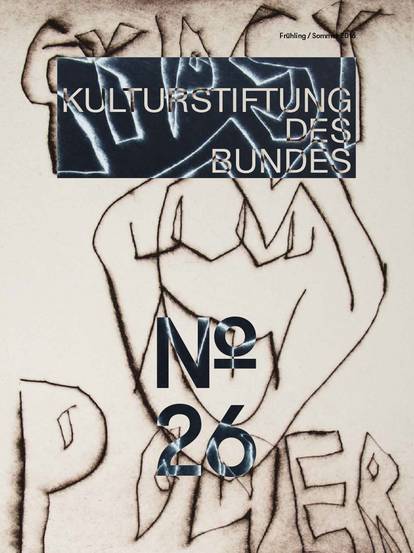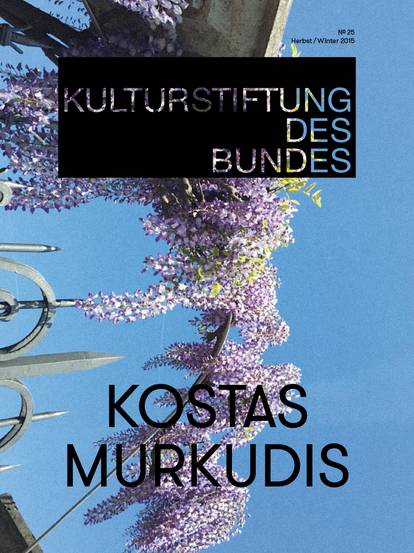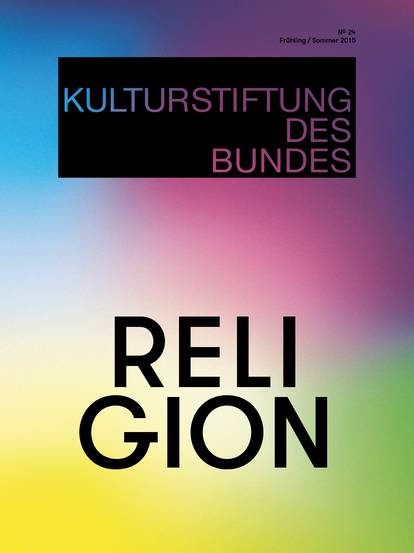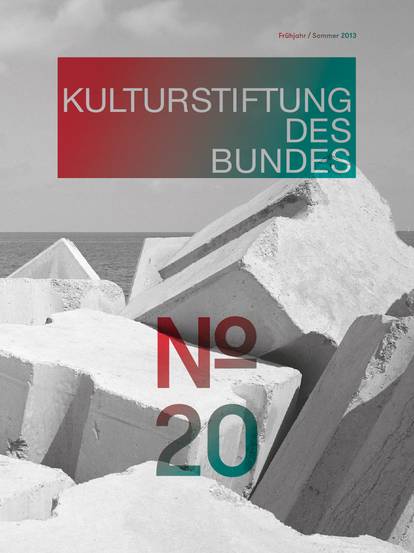An oversized cluster of cells flies through the forest. Seeds pierce the membrane that protects the pulsating creature within. The boisterously bright slogan posters seem out of place in the White Cube. Absurd sentence constructions flash across the outer facade of the Kunsthaus Graz. Tristan Schulze’s artistic works are as diverse as their forms of presentation. While his BIOMACHINE I has an algorithm-generated amorphous entity explode across the screen of a digital terminal – immediately calling to mind Pokémon Go – the piece BITE features various scanned works by his fellow exhibited artists, revamped into new poster designs and presented on monitors. The author of the superimposed slogans, such as “YOU ARE LOST”, “SAVED MY LIFE” and “FEEL IT HEAVY”, is an artificial intelligence which was trained to describe the selected graphic images as fittingly as possible. The underlying algorithm draws its vocabulary from the comments and descriptions of contemporary art in social networks.
Tristan Schulze, a trained and certified interaction designer, playfully combines his autodidactically acquired technical know-how with art-world themes. His works exude the joy of programming, experimenting with the possibilities of algorithms, AI (artificial intelligence) and AR (augmented reality). The final products don’t have to be digital; for the series Tapestry, he trained an AI to create and individually interpret traditional weaving and knotting patterns. The data basis was comprised of carpets of various origins and ages. The AI interpreted the patterns from Persia, China, Europe and India to create its own designs. The technical process is clearly evident in the final product: the human hand is capable of executing the weaving and knitting patterns more flexibly to ensure the greatest strength and stability. The AI-produced textiles, on the other hand, were clearly flimsier, yet aesthetically pleasing.
“The medium is the message.” This often-quoted theory by Marshall McLuhan, which proposes that media affects our senses even before we perceive the content it communicates, is key to Schulze’s works. For alongside the thematic discussion, e.g. on the relationship between humans and the environment, authorship and copyright, artistic appropriation and the propagation of traditional cultural techniques like weaving and knitting, one can always sense a subversive critique in his works – even if not explicitly expressed – of our insufficiently critical attitude toward technical progress.
The dialectic of joyful technical experimentation and the criticism of being uncritical is most evident in the piece {Ghost}, a project on machine intelligence created for the Kunsthaus Graz in 2017 and initiated by its director Barbara Steiner. Visitors to the exhibition can engage in dialogue with a digital machine using their smartphones. The vocabulary of the artificial neural network was generated from previously published texts by the Kunsthaus – press releases, social media pieces and catalogue articles. After being fed with this information, the algorithm was able to produce its own sentences or truisms, such as “I can feel it”, “Youth is sex”, “Feelings is inverted zeitgeist”.
The visitors were then allowed to decide whether these sentences should be flashed across the facade of the Kunsthaus, which doubles as a large-scale video screen thanks to its integrated LEDs and amorphously convex form similar to the digital billboards in New York’s Times Square. Even some inherently questionable absurdities, like “Are you annoyed of Standard?” or “Product is Fascism” were given the green light and could be seen and read from afar by the city’s residents.
Tristan Schulze doesn’t only create art that reflects on our digital reality. He borrows the means and methods of this parallel world whose potentials – and dangers – only but a few of us fully appreciate. “We shape our tools, and thereafter, our tools shape us,” as McLuhan declared in 1967.
His latest work SUPER_ID, which he developed exclusively for this magazine, genuinely ascribes to this premise. At the interface between art and technology, Schulze uses an app as the medium to explore the subject of identity in the digitalised world. With his app SUPER_ID, the user can create his/her own “super-identity” in the form of a mask which reacts to one’s facial expressions and voice in real time. The mask encrypts this biometric data and becomes an aesthetic digital accessory which asks how we wish to be represented in the digital sphere in the future.
Tristan Schulze is a designer, artist and lecturer. As part of the artistic staff at Burg Giebichenstein University of Art and Design in Halle, he teaches courses in the area of multimedia / virtual reality. His exhibitions and projects in past years have been featured at KINDL – Centre of Contemporary Art in Berlin, the ZKM | Centre for Art and Media in Karlsruhe, the ACC Galerie in Weimar and the GfZK in Leipzig.
He expresses his enthusiasm for artistic activity and technical experimentation in completely “analogue” ways as well. In January 2017 he took up residence at the Room for Drastic Measures e.V. in Berlin for one week. Apart from fixed break times, he lived and worked there 24/7, slept in a camping tent and was subjected to the curious glances of passers-by. Analogous to a human algorithm, he followed a set of rules for creating a mural. Various sequences dictated the length of the lines and the size of clusters and spacing, and ultimately the composition itself. As the “drawing entity”, Schulze assumed the role of a programmed agent and worked according to his prescribed set of rules which were marked by errors and improvisation.
Be it analogue or digital, Tristan Schulze calls for an experimentally friendly, but reflective and critical approach to algorithms, AI and AR, which are certain to infiltrate our everyday lives and bodies in the near future in the same way apps and emails already do today. Is that something we want? And if so, in what form? With his works, Schulze belongs to the avant-garde in the truest sense of the word. He is a pioneer of an intellectual trend that will not stop at contemporary art and poses technical, aesthetic and thematic challenges to its recipients, curators and critics much like video art did in the 1970s.
Ob analog oder digital, Tristan Schulze appelliert an einen experimentierfreudigen wie reflektiert-kritischen Umgang mit Algorithmen, KI und AR, die in naher Zukunft unseren Alltag und unsere Körper durchdringen werden, wie es Apps und E-Mails heute schon selbstverständlich tun. Wollen wir das? Und wenn ja, in welcher Form? Mit seinen Werken gehört Schulze im wahrsten Wortsinn zur Avantgarde, zu den Vorkämpfern einer geistigen Entwicklung, die vor der zeitgenössischen Kunst nicht Halt macht und Rezipienten, Kuratorinnen und Kritiker ebenso vor Herausforderungen im Hinblick auf technische, ästhetische und inhaltliche Aspekte stellt, wie es die Videokunst in den 1970er Jahren getan hat.
Note: You can access the AR content of this article via the issuu-paper of this magazine. (external link, opens in a new window)

![[Translate to English:] Magazine 38](/fileadmin/_processed_/f/1/csm_Magazin38_Cover-Vorschau_921x1230_689f428dc3.jpg)
![[Translate to English:] Magazine 37](/fileadmin/_processed_/b/c/csm_Mag37_Cover-Vorschau_921x1230_b5129fdb2a.jpg)
![[Translate to English:] Magazine 36](/fileadmin/_processed_/2/a/csm_Cover_Magazin36__issuu_2f3cef97bb.jpg)





![[Translate to English:] Magazine 30](/fileadmin/_processed_/c/b/csm_magazin30_vorschau_9005f773d3.jpg)














